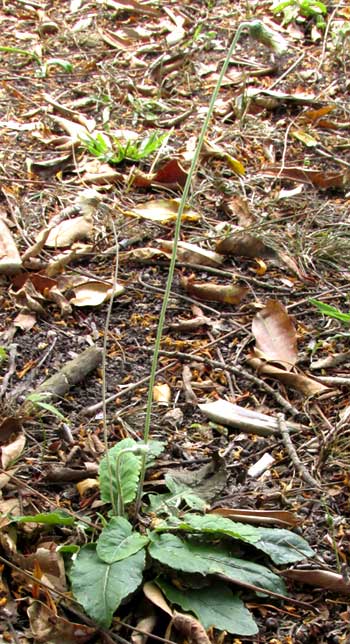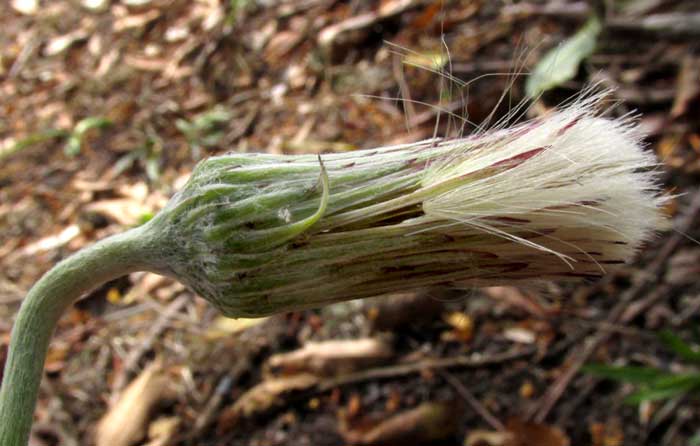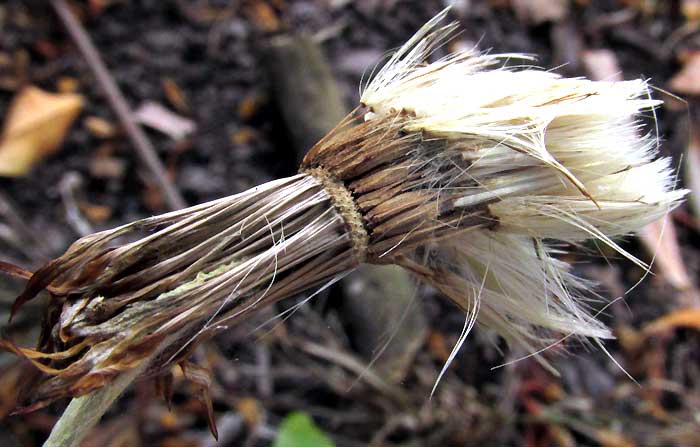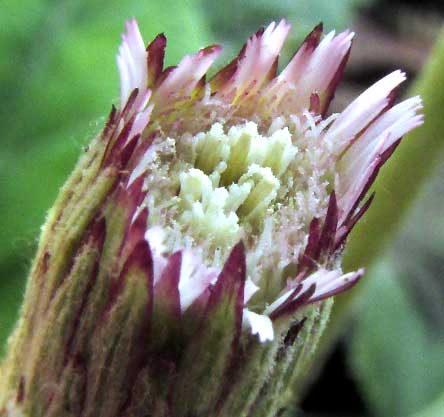Excerpts from Jim Conrad's
Naturalist Newsletter
from the April 27, 2019 Newsletter with notes from an early April camping trip in the Petén department of northern GUATEMALA
SILVERPUFF
Earlier this month, on April 3rd, as I wandered the campground of El Rosario National Park in northern Guatemala's lowland Petén department, on the east side of Sayaxché (elevation about 125m, or 410 ft, ~N16.525°, ~W90.160°), on the bank right next to the lake below the campground, it looked like an old friend had taken up residence. Below, you can see my friend's long, slender neck kinked at the top, with a downward nodding head:

This plant's general growth pattern -- what appears to be a flowering head atop a long, slender stem, or scape, emerging from a rosette of leaves at the base -- suggests the enormous Composite or Aster Family, the Asteraceae. Dandelions, for instance, are members of the family and display such a pattern. The flowering head on our Guatemala plant was a little past its time, about to burst into a Dandelion-puffball-like head of white-parachuted, achene-type fruits, as shown below:

That picture nicely shows the narrow, green, overlapping bracts forming a cup-like structure, the involucre, below the emerging seed head. On another plant, an older head had its bracts turned back, revealing the brown achenes, and the achene's white fuzz that later would dry out and fluff, and serve as wind-catching parachutes -- all very similar to Dandelion fruiting heads -- shown below:

Surprisingly, however, a close look inside a flowering head dispelled any ideas that our Guatemala plant might be closely related to the Dandelion. Some convergent evolution has been going on here. You can see what I mean below:

Dandelions belong to that tribe of Composite Family members whose flowering heads consist only of flat, strap-shaped, ray-type florets. In the above picture, white ray florets -- each tipped with tiny, shallow "teeth"-- occur along the flowering area's perimeter, but also inside the perimeter, many cylindrical, disc-type florets are crammed together to form the "eye." Our Guatemalan plant's heads bear both ray and disc florets, and thus it occupies a branch of the Aster Family phylogenetic tree well apart from the dandelions.
All these features were just like those displayed by plants we got to know back in Texas, known as Silverpuffs, Chaptalia texana. You can review our Texas plant at www.backyardnature.net/n/h/silvpuff.htm
Even our Guatemala plant's rosette of leaves looked like those of the Texas Silverpuff, as you can see at www.backyardnature.net/n/19/190427cl.jpg
It turns out that sometimes the Texas plants, Chaptalia texana, have been regarded as a variety of our Guatemalan taxon, which is CHAPTALIA NUTANS. Chaptalia nutans is widely distributed from the southwestern US south through Mexico and Central America, deep into South Ameirca, so maybe they are indeed the same species.
If you do a search on Chaptalia nutans, you'll find that in English sometimes it's referred to as "I'm Not Happy," apparently taken from the Spanish name "No Soy Feliz." The name may result from its medicinal and magical use in some places as an antidepressant, as among the Guaraní of Paraguay.
With regard to other medicinal uses, it's as I reported for the Texas species, or variety, that it "... has been used traditionally for 'cleansing the blood and digestive system as part of an aphrodisiac,' plus so many other uses are documented that you wonder if any are valid."